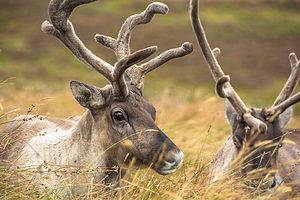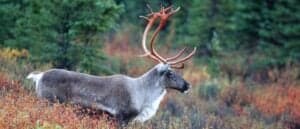Although they may appear similar at first glance, the moose and the reindeer have numerous important distinctions. Since they are both members of the Cervidae family, moose and reindeer have similar morphologies. Moose, however, is the largest member of the deer family (Alces alces), while reindeer are smaller Arctic and subarctic-dwelling deer of the Rangifer tarandus species. Curious to learn more? This article examines everything about moose vs. reindeer, including major differences in appearance, characteristics, habits, and habitats. Let’s go!
Moose vs. Reindeer: A Comparison
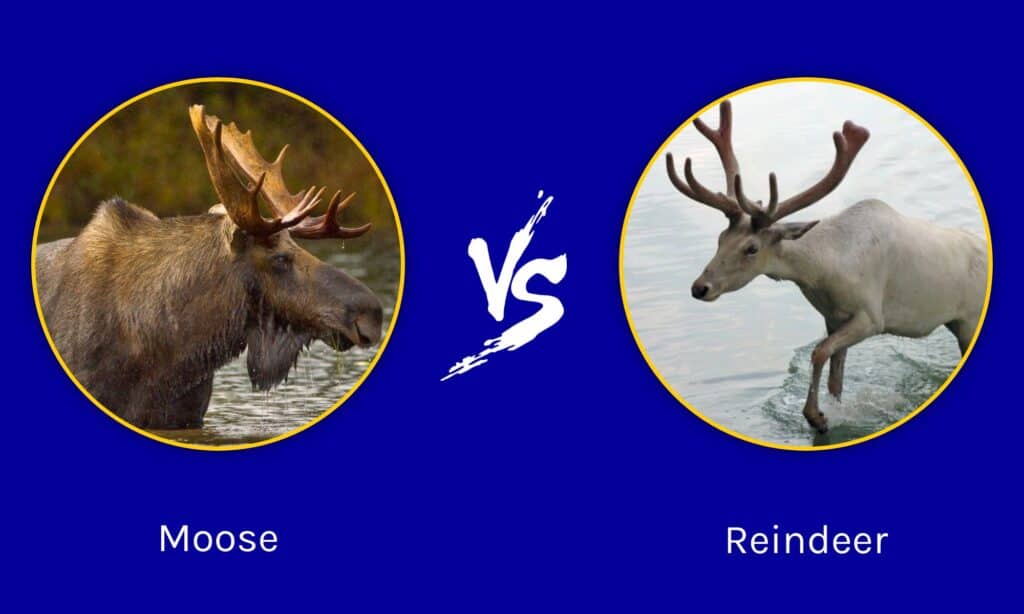
| Moose | Reindeer | |
|---|---|---|
| Size | 6 ft long, Up to 1800 lbs. | 4 to 6.8 ft long, Up to 700 lbs. |
| Colors | Golden Brown to Black | Variety of Colors |
| Physical Features | Long Head, Large Nose, Small Ears, Short Tail | Large Cloven Hoofs, Whitish in Winter, Brown in Summer |
| Danger | Normally Harmless, Can Turn Hostile When Hungry | Not Normally Dangerous To Humans, Unpredictable. Males Are Territorial |
| Diet | Herbivore; Leaves And Twigs Of Woody Plants | Herbivore; Moss, Herbs, and Ferns |
| Lifespan | 15 to 20 Years | 12 to 15 Years |
| Habitats | Northern U.S.; Colder Climates | Arctic Tundra, Boreal Forests |
| Habits | Solitary Creatures | Feed, Travel, and Rest Together |
Key Differences Between Moose vs. Reindeer
The key differences between a moose and a reindeer are size, appearance, lifespan, habitat, habitat, and physical features. Reindeer inhabit both the eastern and western hemispheres’ colder regions. In Eurasia, these animals are referred to as reindeer and in North America as caribou. In the Northern Hemisphere, moose inhabit temperate or subpolar areas. While in North America we use the term moose, in Eurasia, they are known as elk.
Size
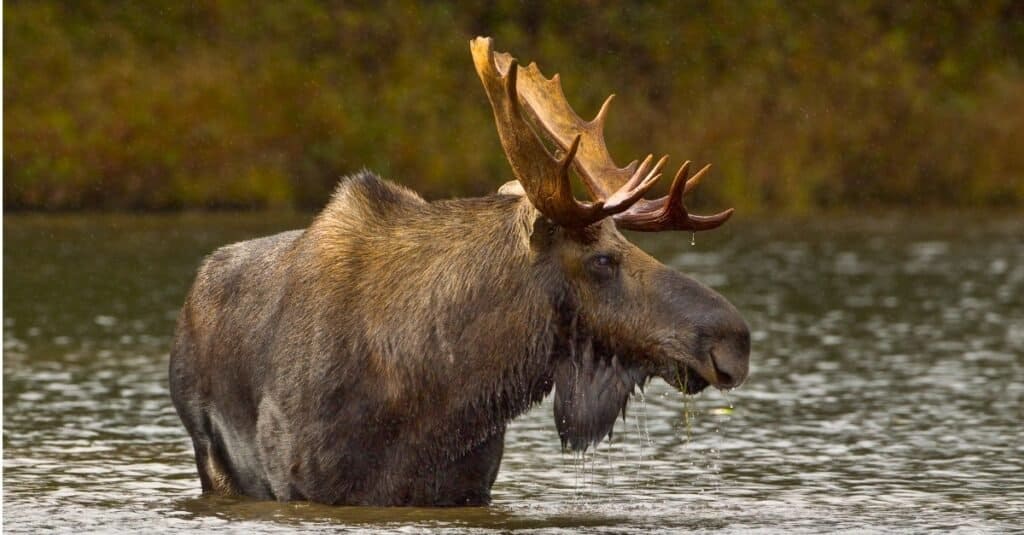
Moose have a larger weight than reindeer.
©iStock.com/RichardSeeley
Moose can weigh up to 1800 pounds and grow to be 6 feet long from hooves to shoulders. Male reindeer reach a height of 28 to 53 inches from hooves to shoulder and a length of 4 to 6.8 feet. Females are typically shorter, measuring between 5.5 and 6.2 feet in length. Males weigh between 143 and 529 pounds, while females weigh between 121 and 308 pounds.
Colors
Reindeer have traditionally come in a variety of colors and sizes depending on the region. A reindeer’s color ranges from virtually black to white. These colors are known by many different names. A black reindeer is called “musikki,” a light-colored reindeer is called “suivakko,” and a white reindeer is called “valkko.”
Moose can be golden brown to virtually black in color, depending on the season and the animal’s age. Within a few weeks, the red-brown coat of newborn calves fades to a light rust tint. By late summer, the calves have shed this coat and grown a coat that resembles that of adults in texture and color.
Physical Features
The head of a moose is long, with a large nose and top lip. It has small ears, a short tail, and a dewlap around its neck. It has a humpbacked appearance due to its robust shoulder muscles. The male moose has massive broad and flat antlers that can span 4 to 5 feet across. Reindeers have deep cloven hoofs that allow them to spread their feet on snow or soft ground, and they are excellent swimmers. In the winter, they are whitish, while in the summer, they are brown.
Danger
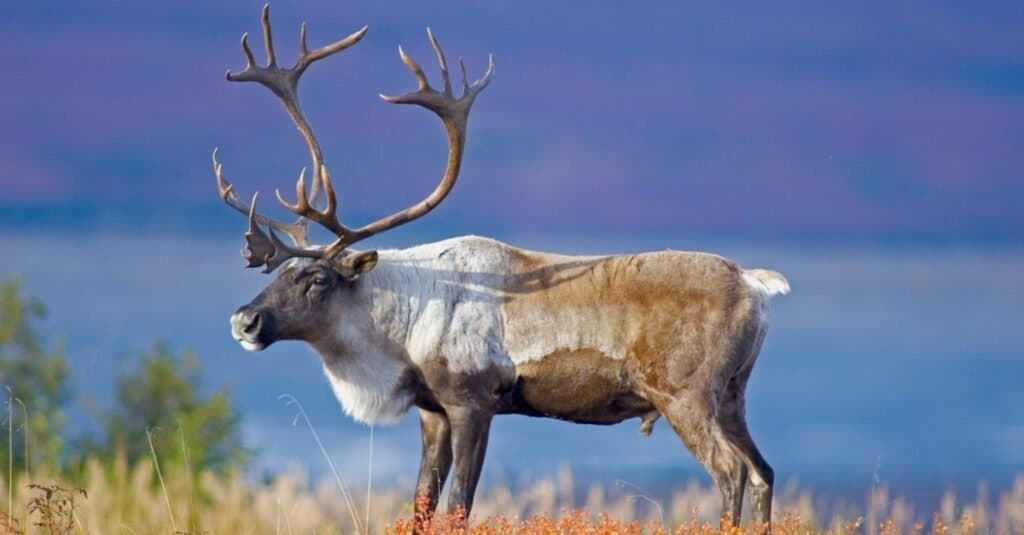
Reindeer are not normally a threat to human.
©Jeff McGraw/Shutterstock.com
Reindeer are not normally dangerous to humans and frequently easy to kill, despite their unpredictability. The male sheds his antlers after the rut in November, while the female sheds hers after calving in the spring. Each male, or bull, will have a harem of females and will become unpredictable and hostile toward anyone who comes close.
Moose is normally harmless, but if harassed by humans, domesticated pets, or traffic, it can turn hostile. It can also act irrationally when hungry or fatigued, especially in the winter when it jas to walk through deep snow. Moose outnumber bears three to one in Alaska, and they hurt about five to 10 humans each year. In Alaska, that’s higher than the total number of grizzly and black bear attacks.
Diet
Moose are herbivores, which means they only consume plants. They feed on the leaves and twigs of woody plant species. The diet of a moose mostly consists of leaves, twigs, buds, and water plants. Willows, birches, aspens, maples, firs, and viburnums are just a few of their favorite foods. Moose prefer regions that have recently been logged or devastated by fire, wind, or beaver because new plant growth has sprung up.
Mosses, herbs, and ferns are among the plants that reindeer eat, as well as grasses, weeds, shrubs, and trees, such as willow and birch. In the winter, it eats lichen (also known as reindeer moss) and mushrooms, using its hooves to scrape snow off the ground. A reindeer’s daily food intake ranges from 9 to 18 pounds on average. Reindeer, sometimes known as caribou, eat primarily plants such as leaves, mushrooms, and the eggs of birds, as well as the arctic char from time to time. Even though it doesn’t have access to carrots and apples in its natural habitat, it likes them as a delightful treat.
Lifespan
In the wild, moose can live for more than 20 years, but many show signs of aging before that. The average lifespan is between 15 and 20 years. Massive and magnificent, moose are a beloved North American wildlife symbol. Researchers believe they have discovered the world’s oldest wild moose, a 22-year-old Isle Royale cow. Reindeer can live up to 15 years in the wild.
Habitat
Moose can be found in the Northern United States, from Maine to Washington, as well as in Canada and Alaska. They are restricted to frigid climates due to their big size and protective fur. Moose thrive in forested settings with streams and ponds. Reindeer, sometimes known as caribou in North America, is a deer species found in Greenland’s Arctic tundra and neighboring boreal forests, as well as Scandinavia, Russia, Alaska, and Canada.
Habits
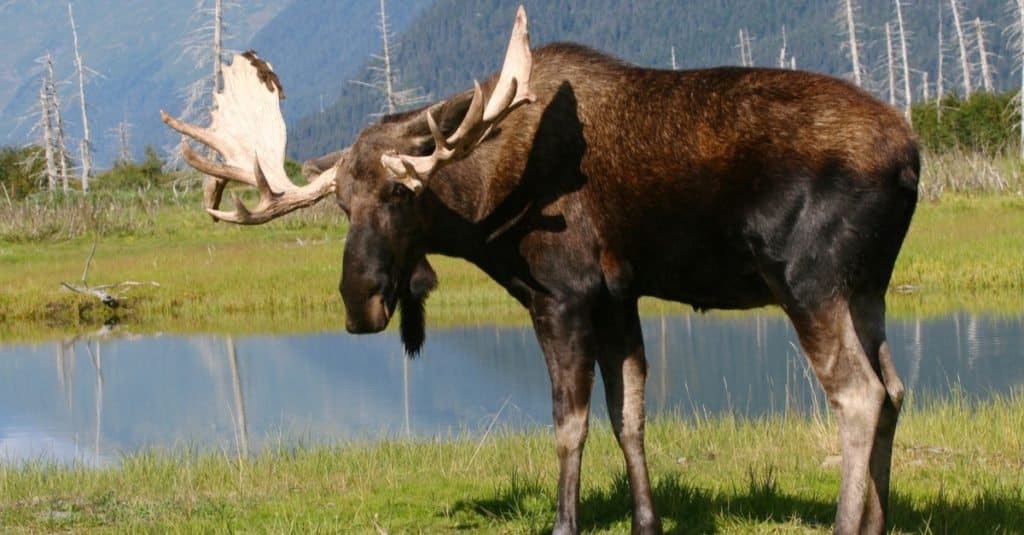
Surprisingly, moose are powerful swimmers.
©Steve Bower/Shutterstock.com
Herds of reindeer feed, travel, and rest together. According to the San Diego Zoo, these herds can range in size from ten to several hundred animals. Herds can increase in size from 50,000 to 500,000 members in the spring. Moose are solitary creatures, with the greatest ties formed between mother and calf. At times, two people will feed on the same stream. Herds are most common during the breeding season, however, only two adults may be present.
Wrapping Up: Moose vs. Reindeer
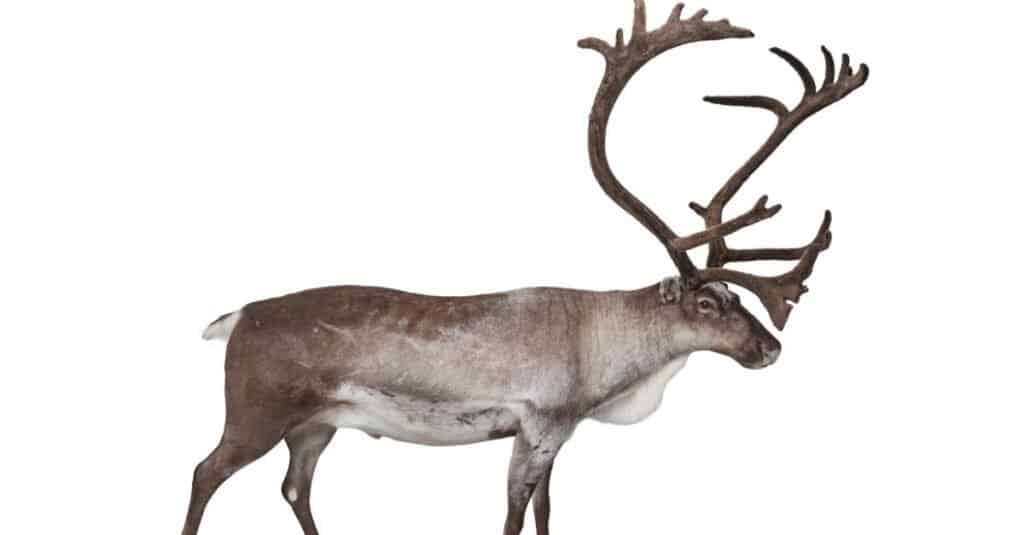
Reindeer have antlers covered in velvet.
©iStock.com/klikk
The primary distinction between moose and reindeer is that moose are heavier, whereas reindeer have proportionally greater antlers. In addition, reindeer antlers are covered in velvet, but moose antlers are not. The habitat of moose is comparable to that of reindeer, though they favor moderate and cool climates and woodlands. They do not travel in groups: moose are solitary creatures. Reindeer are found in the Arctic tundra and neighboring boreal forests. Moose inhabit the northern parts of North America, mainly Canada and Alaska.
The photo featured at the top of this post is © iStock.com/KenRinger
Thank you for reading! Have some feedback for us? Contact the AZ Animals editorial team.




